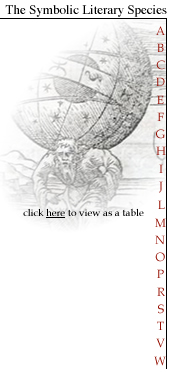
The Symbolic Literature of the Renaissance


Support the Library!
Buy your books here.
home
authors
books
contributors
books for sale
links

| ||||
|
|
The Library of Renaissance Symbolism The Symbolic Literature of the Renaissance |
 
|
||
|
Support the Library! |
Find On Worldcat |
Find On This Site |
||

|
FABLES Latin: Fabulae Authorities: Estienne, Gracian, Hoskins, Menestrier, Tesauro
Fable (fabula) has its origin in farior, Latin, 'I speak' The history of the fable in the West originates with Aesop who is believed to have been a historical figure born a slave in about 620 BC although the place of his birth is uncertain. The first written version of the fables, probably made by Demetrius of Phalerum, a pupil of Theophrastus, appeared about 300BC and thereafter there were many further versions and imitations up to the end of the Roman period. Even at this early date at least some of these versions were illustrated since Philostratus in his Imagines specifically comments on illustrated fables. Another strand were the Libyan fables which may have been composed by one Aristides of Miletus, Aristotle describes ‘Libyan stories’ and Aesop’s fables as two separate but similar genres. The story of Cupid and Psyche is presumed to be the only Libyan fable to have survived since Apuleius in the Golden Ass calls it a 'Milesius sermo'. A further genre was the so-called Fables of Bidpai derived from the Indian Panchatantra written in Sanskrit about the 4th century AD and coming to Europe via Persian, Arabic, Greek and Latin translations. They were rendered into several European vernacular languages in the 16th century and the first English version was by Sir Thomas North in 1570 and called the Moral Philosophy of Doni after the Italian author from whom in turn it was translated. La Fontaine acknowledged that he owed a number of his fables to Bidpai.
Aesop’s fables were translated by Lorenzo Valla and printed widely including in an edition by Caxton in 1485 which he had translated himself. Such was the fascination with Aesop that there was even a maze in the gardens of the Chateau of Versailles, the palace of Louis XIV, in which were placed statues and inscriptions that illustrated the Fables (Perrault 1675). Aesop’s Fables is generally regarded as the most widely circulated book of all time after the Bible and no lesser an authority than Luther himself accorded them the same prestige as books of the Bible. ‘We will make a Zion…..and we will build there three tabernacles, one for the Psalms, one for the Prophets, and one for Aesop.’ There were other other influential collections. Marie de France who has been described as the greatest woman writer of the Middle Ages wrote a book of fables in the 12th Century which was very popular; some 23 manuscripts of the poems survive. In the 15th Century fables were composed by contemporary writers such as Laurentius Abstemius and Filelfo. Gilles Corrozet published in 1542 his fable book, Les fables d’Esope Phrygien, Fables of Aesop the Phrygian and according to Landwehr, some 300 fable books were published just in Holland during this period testifying to the popularity of the genre. In the late 17th century, La Fontaine was the most celebrated of all contemporary fable writers of the time. His output reminds us of the oeuvre of Phaedrus since he started by emulating Aesop and then expanding into general satire of contemporary life and human folly. The fable is obviously a naïve form of allegory with its emphasis on stories of animals which behave like human beings. The personification and caricature of animals enabled the less savory extremes of human character to be described in a summary and simple manner which in turn emphasized the moral of the story. Early fables also recounted tales of gods, men and inanimate objects of nature but fables can be distinguished from allegory and parable by their combination of wit and morality. They are essentially lighthearted, often merely jokes whose subtle references could be fully appreciated by the listeners of the time. Many of the fables in the form we now have them end with the moral of the story being summarised in a single sentence called epimythia (or afterword) and these may very well have been added by later anthologists as a quick identifier for exercises in Rhetoric. These summaries were the origin of the commentaries which were added first to the emblems of Alciato with the French edition by Aneau of 1549 and then to subsequent editions and texts evolving themselves into the essay form pioneered by Montaigne in 1580. See also: Emblems, Allegories, Jokes
|